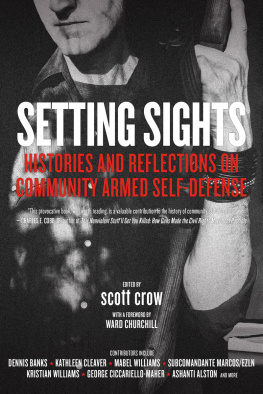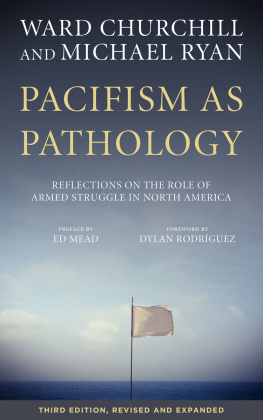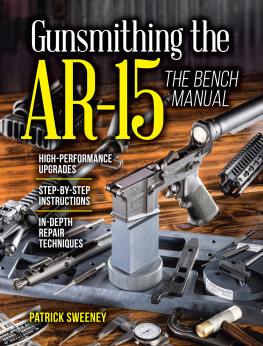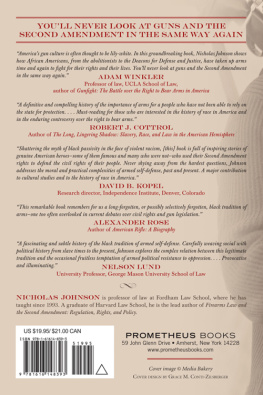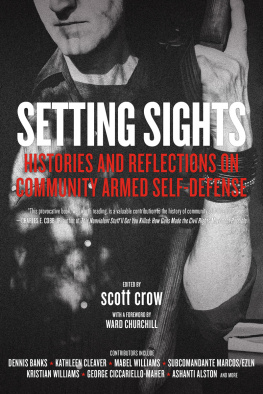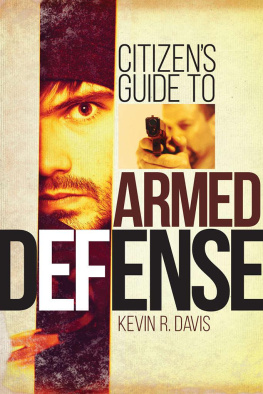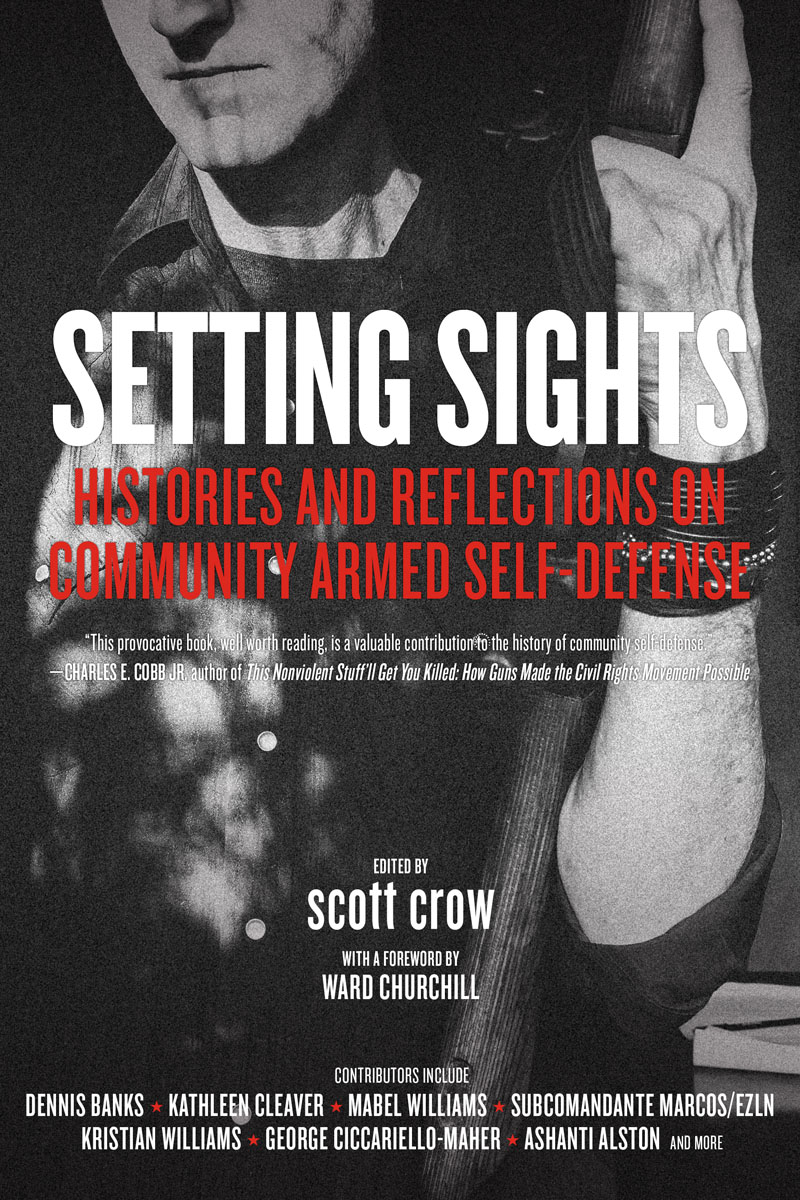
Setting Sights: Histories and Reflections on Community Armed Self-Defense
Edited by scott crow
Essays by scott crowLiberatory Community Armed Self-Defense: Approaches toward a Theory, On Violence, Disasters, Defense and Transformation: Setting Sights for the Future, Sometimes Stories Reveal Themselves, Introduction: As Rare as Flowers Rising through Concrete: Why Liberatory Community Armed Self-Defense?are licensed under a Creative Commons Attribution-ShareAlike 3.0 Unported License 2017

All other essays 2018 by the named respective authors.
This edition 2018 PM Press
PM Press
PO Box 23912
Oakland, CA 94623
www.pmpress.org
Cover design by John Yates / www.stealworks.com
Cover photo by Leon Alesi / www.leonalesi.com
Interior design by briandesign
ISBN: 9781629634449
Library of Congress Control Number: 2017942918
10 9 8 7 6 5 4 3 2 1
Printed in the USA by the Employee Owners of Thomson-Shore in Dexter, Michigan.
www.thomsonshore.com
This book is dedicated to those who have
exercised power for collective liberation on
their terms by any means necessary.
Dream the future
Know your history
Organize your people
Fight to win
Contents
scott crow
Ward Churchill
scott crow

scott crow
Neal Shirley/North Carolina Piece Corps
Kristian Williams and Peter Little
Chad Kautzer
J. Clark
Ashanti Alston
Western Unit Tactical Defense Caucus
Leslie James Pickering
Gustavo Rodrguez
North Carolina Piece Corps

Paul Avrich
Shawn Stevenson
Anti-Fascist Action UK
Helge Dhring and Gabriel Kuhn
Lamont Carter and scott crow
David Cecelski
Kathleen Cleaver and Mabel Williams with an introduction by Angela Y. Davis
Akinyele Omowale Umoja
Nikki Craft
Gord Hill
scott crow
Michele Rene Weston
Laura Gallery
Subcomandante Marcos
scott crow
Suncere Shakur
Simn Sedillo
Mo Karnage
George Ciccariello-Maher
Dave Strano
Interview by scott crow
Alexander Reid Ross and Ian LaVallee
Sometimes Stories Reveal Themselves
scott crow
In war, things get confused out therepower, ideals, the old morality, practical military necessity.
General Corman, in the film Apocalypse Now
This book grew organically out of conversations between people in Lawrence, Kansas, and Austin, Texas, which evolved into a collaborative pamphlet called Desire Armed: An Introduction to Armed Resistance and Revolution, released in 2006. (The people in Lawrence did the heavy lifting on the project, for which I am grateful.) The subjects varied from self-reflection and theory, to the history and basics of gun use. As a text, it was limited, but powerful.
When that pamphlet was written there were at most a handful of leftist, radical, or anarchist groups talking about the use of firearms at all, except in historical settings or some far-off revolutionary future. I was part of an anti-fascist defense caucus that trained on firearms use, safety, and tactical considerations together as part of our organizing within the Anti-Racist Action network. In Lawrence their organizing was largely around Kansas Mutual Aid and the John Brown Gun Club, which both focused on working with rural and low-income whites as part of food, housing, and other organizing programs.
Once released, the pamphlet took on a life of its own and now appears worldwide in many DIY and small press editions. I knew there was much more to be written, more histories to uncover, analyses and theories that needed to be heard and discussed by more people. Thats when the idea to expand the zine into this book, Setting Sights: Histories and Reflections on Community Armed Self-Defense, germinated. Over the next several years I researched materials, interviewed people, and collected new or undiscovered essays and articles from around the world on the subject of community armed self-defense. Almost twelve years later, this book is the culmination of that work. I hope you find it engaging and thought-provoking.
Dream the Future Know
Your History
Organize Your People
Fight to Win
scott crow
From the concrete jungle in the Gulf Coast Basin
2017
Gun Control Means Being Able to Hit Your Target
Ward Churchill
The struggle of man against power is the struggle of memory against forgetting.
Milan Kundera, The Book of Laughter and Forgetting
Once upon a time, believe it or not, the right inhering in all communities to defend themselves by force of arms against the violence of external assault was so well understood that it was not thought worthy of serious discussion.
Notwithstanding the contentions of Michael Bellesiless Arming America, guns were as common as axes on the North American frontier during the period leading up to the thirteen colonies armed struggle for independence, and far more essential to survival. Hence, the Second Amendment to the U.S. Constitution acknowledged the right of citizens to keep and bear arms and placed it quite solidly on a military footing having nothing whatsoever to do with a desire to preserve certain sporting indulgences for posterity. The character of this provision is readily apparent in the framers explicit reference to the necessity of a well regulated Militia in defending the U.S. free State against armed aggression by foreign powers. Indeed, as John Grenier ably demonstrates in The First Way of War, the countrys military capacity remained almost entirely contingent upon the existence of local militias well into the nineteenth century. No less clarifying are the numerous observations of Jefferson and others among the founding fathers to the effect that an armed populace embodies the most effective barrier to the domestic state itself evolving toward a tyranny.
On both counts its obvious that the types of arms envisioned were not of the variety used for hunting rabbits, squirrels, and deer, but those employed by modern armies. In contemporary terms, this would equate to real military-issue assault rifles, not the semiautomatic civilian models commercially available to the public. It would also be well to remember that it was not especially unusual for local militias, to say nothing of corporate entities like the American Fur Company, to equip themselves with their own artillery, and that the central government did little, if anything, to questionand less still to curtailtheir right to do so until the 1860s.
It can be argued, and rightly so, that since the society on whose behalf these principles were set forth was composed all but exclusively of white settlersthis is to say, invadersit was by definition everywhere and always the aggressor, and consequently had no basis upon which claim a right to self-defense, armed or otherwise. Put another way, no matter how often or savagely indigenous peoples might attack, they can only be seen as defending their own communities against the genocidal onslaught they were suffering. It follows that, irrespective of the white supremacist hypocrisy imbuing the outlook of those who enshrined it in written form, the principle holds. American Indians had every right to fight back with every weapon available to them, and one can only wish that these had included rocket launchers and machine guns.
Next page
